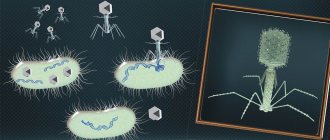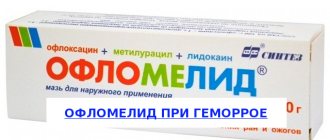Back to list Previous article Next article
03.11.2017
Tags:
pseudomonas, pseudomonas
Vote
Discovery History
In 1855, during the Crimean War, the French surgeon S. E. Sedillot discovered that some soldiers had purulent wounds that turned the dressing material an aquamarine color. The same doctor was the first to call living beings invisible to the naked eye microbes. The pigment itself, which is secreted by bacteria during this infection, was discovered in 1860, and in 1862 Luke linked pyocyanin with microorganisms found in wounds. Because of this feature, these bacteria were called Pseudomonas aeruginosa.
Properties
The temperature optimum is +37°C, but this microorganism is capable of living and developing up to a temperature of +42°C. Releases pigments:
- blue-green pyocyanin;
- yellow-green pyoverdine;
- brown pyoverdine.
The latter fluoresces when exposed to UV radiation. Bacteriologists also noticed that the media on which Pseudomonas aeruginosa grows acquire a characteristic odor reminiscent of the aroma of strawberry soap. Capable of existing only in the presence of oxygen, that is, it belongs to obligate aerobes.
Pseudomonas are characterized by the formation of a biofilm by cell aggregation and the release of polysaccharides into the external environment, which protects the colony from unfavorable conditions. This ability arises due to quorum sensing - the orderly and coordinated behavior of bacteria by transmitting signals through chemical compounds. Therefore, bacteria of this genus are resistant to many disinfectants and antibiotics, which often leads to outbreaks of nosocomial infections.
Pseudomonas (pseudomonas, genus of bacteria)
Pseudomonas
(lat.
Pseudomonas
) - a genus of gram-negative aerobic non-spore-forming bacteria. Pseudomonas are mobile and have the shape of straight or curved rods and two polarly located flagella. Pseudomonas are widely used in economic practice, for the production of antibiotics, the extraction of residual oil from wells, to combat environmental pollution, and also as models for numerous theoretical studies.
Pseudomonas aeruginosa and other species causing human infections
The most important species from a medical point of view is Pseudomonas aeruginosa
(Pseudomonas aeruginosa) - one of the main causative agents of local and systemic purulent-inflammatory processes, especially in hospital settings. The risk of developing infection caused by Pseudomonas aeruginosa increases significantly in patients with impaired barrier systems and resistance factors. Patients weakened by cystic fibrosis, as well as those suffering from neutropenia, are at particular risk of developing severe infections caused by Pseudomonas aeruginosa. Infections caused by pseudomonas most often develop in premature infants, in children with congenital anomalies and in patients with leukemia, in patients with burns, in elderly patients with debilitating diseases. Most of these infections are observed in hospitals, and they are infections acquired from the environment rather than from the normal microflora of patients. In hospitals, Pseudomonas aeruginosa is detected on household items, sanitary equipment, including sinks, on urinals, catheters, on staff, as well as in antiseptic solutions and aqueous solutions of medications. Pseudomonas aeruginosa is found in the intestines of approximately 5% of healthy adults; the carriage rate increases in hospitalized patients.
At the same time, Pseudomonas aeruginosa belongs to the normal microflora of humans and can be found in the intestines, respiratory tract and on the skin of healthy people.
Except Pseudomonas aeruginosa
human infectious diseases can be caused by some other types of pseudomonas, which, like
Pseudomonas aeruginosa
, can cause pneumonia, bacteremia, and septemia.
Statement 3: “Components of the gastric microbiota may play a role in the development of H. pylori
Pseudomonas
are more identified than in patients with atrophic gastritis (Starostin B.D. ).
Pseudomonas spp.
are isolated in sepsis, Crohn's disease (Karpeeva Yu.S. et al.).
Pseudomonas - causative agents of diseases of the genitourinary organs
Pseudomonas can cause various diseases of the genitourinary system. Pseudomonas spp.
are the cause of 6% of all cases of acute prostatitis, they can also cause epididymitis (inflammation of the epididymis), orchitis (inflammation of the testicle).
Pseudomonas syringae
Pseudomonas lilac (lat. Pseudomonas syringae
) is a species of phytopathogenic pseudomonas that causes diseases in a large number of plants, expressed in the form of brown mucus, frostbite, fruit damage and leaf spot.
There are about 50 pathovars (strains) of Pseudomonas syringae
, capable of infecting different types of plants, in particular, beets, wheat, barley, beans, peas, millet, maple, ash, oleander, olive trees, apple trees, lilacs and others.
Antibiotics, active and inactive against pseudomonas
Antibacterial agents (those described in this reference book) active against pseudomonads: rifaximin. Ciprofloxacin is active against Pseudomonas aeruginosa.
Pseudomonas aeruginosa is resistant to tetracycline.
Levofloxacin is active against Pseudomonas aeruginosa
and
Pseudomonas fluorescens.
Norfloxacin is active against
Pseudomonas aeruginosa, Pseudomonas fluorescens, Pseudomonas stutzeri.
Pseudomonas is resistant to nifuroxazide and roxithromycin.
Pseudomonas in ICD-10
Pseudomonas
are mentioned in the International Classification of Diseases ICD-10:
- in "Class I. Certain infectious and parasitic diseases (A00-B99)", in block "B95-B98 Bacterial, viral and other infectious agents", in heading "B96.5 Pseudomonas
(
aeruginosa
) as a cause of diseases classified elsewhere " This code is intended to be used as an additional code when it is advisable to identify infectious agents of diseases classified in other headings - in "Class X. Respiratory diseases (J00-J99)", block "J10-J18 Influenza and pneumonia", in the heading "J15.1 Pneumonia caused by Pseudomonas
"
Pseudomonas in the taxonomy of bacteria
The genus Pseudomonas ( Pseudomonas
) is in the family
Pseudomonadaceae
, order
Pseudomonadales
, class Gammaproteobacteria (
γ proteobacteria
), phylum Proteobacteria (
Proteobacteria
), kingdom Bacteria.
Genus Pseudomonas
includes the following groups and types of bacteria:
- groups: P. aeruginosa group, P. chlororaphis group, P. fluorescens group, P. pertucinogena group, P. putida group, P. stutzeri group, P. syringae group
. - species not included in groups: P. abietaniphila, P. acephalitica, P. acetoxians, P. acidophila, P. agarici, P. agarolyticus, P. alcaliphila, P. alginovora, P. alkylphenolica, P. andersonii, P. antarctica, P. argentinensis, P. arsenicoxydans, P. asplenii, P. asuensis, P. auricularis, P. azotifigens, P. baetica, P. batumici, P. bauzanensis, P. benzenivorans, P. blatchfordae, P. bohemica, P. borbori, P. borealis, P. brassicacearum, P. canadensis, P. capeferrum, P. cerasi, P. chengduensis, P. cinnamophila, P. clemancea, P. coleopterorum, P. collierea, P. composti, P. constantinii, P. cremoricolorata, P. cuatrocienegasensis, P. deceptionensis, P. delhiensis, P. diterpeniphila, P. donghuensis, P. duriflava, P. endophytica, P. entomophila, P. extremaustralis, P. filiscindens, P. flexibilis, P. floridae, P. formosensis, P. frederiksbergensis, P. gelidicola, P. gessardi, P. gingeri, P. glareae, P. graminis, P. granadensis, P. gregormendelii, P. grimontii, P. guangdongensis, P. guariconensis, P. guezennei, P. guguanensis, P. guineae, P. halodenitrificans, P. helleri, P. helmanticensis, P. hunanensis, P. hussainii, P. hydrogenovora, P. indica, P. indoloxydans, P. japonica, P. jessenii, P. kilonensis, P. knackmussii, P. koreensis, P. kunmingensis, P. kuykendallii, P. lactis, P. lini, P. linyingensis, P. litoralis, P. lurida, P. lutea, P. marginata, P. marincola, P. massiliensis, P. matsuisoli, P. meridiana, P. metavorans, P. mohnii, P. moorei, P. moraviensis, P. multiaromavorans, P. mutabilis, P. nitritireducens, P. oceani, P. oryzae, P. otitidis, P. pachastrellae, P. palleroniana, P. panacis, P. panipatensis, P. parafulva, P. paralactis, P. pavonaceae, P. pelagia, P. peli, P. pohangensis, P. populi, P. prosekii, P. psychrophila, P. psychrotolerans, P. pudica, P. punonensis, P. putida group, P. rathonis, P. reactans, P. reinekei, P. rhizosphaerae, P. sabulinigri, P. sagittaria, P. salegens, P. salina , P. salinarum, P. salomonii, P. saponiphila, P. saudimassiliensis, P. saudiphocaensis, P. segetis, P. seleniipraecipitans, P. sesami, P. sihuiensis, P. simiae, P. soli, P. songnenensis, P taeanensis, P. taiwanensis, P. tarimensis, P. teessidea, P. thermocarboxydovorans, P. thermotolerans, P. thivervalensis, P. toyotomiensis, P. trautweinii, P. tropicalis, P. turukhanskensis, P. umsongensis, P. vancouverensis , P. versuta, P. vranovensis, P. weihenstephanensis, P. wisconsinensis, P. xiamenensis, P. xinjiangensis, P. yamanorum, P. yangmingensis, P. zeshuii, P. zhaodongensis, [Flavobacterium] lutescens
.Pseudomonas mendocina
The
Pseudomonas aeruginosa group includes P. aeruginosa
(Pseudomonas aeruginosa)
, P. alcaligenes, P. anguilliseptica, P. caeni, P. citronellolis, P. flavescens, P. jinjuensis, P. mendocina, P. nitroreducens/multiresinivorans group, P. oleovorans/pseudoalcaligenes group, P. cf.
pseudoalcaligenes, P. resinovorans, P. straminea .
Pseudomonas nitroreducens/multiresinivorans group
includes
P. multiresinivorans, P. nitroreducens. Pseudomonas oleovorans/pseudoalcaligenes group - P. oleovorans, P. pseudoalcaligenes.
Pseudomonas chlororaphis group
- P. chlororaphis, P. fragi, P. lundensis, P. taetrolens
.
Pseudomonas fluorescens group
(fluorescent pseudomonads) -
P. azotoformans, P. brenneri, P. cedrina, P. congelans, P. corrugata, P. costantinii, P. extremorientalis, P. fluorescens, P. gessardii, P. libanensis, P. mandelii, P marginalis, P. mediterranea, P. migulae, P. mucidolens, P. orientalis, P. poae, P. protegens, P. proteolytica, P. reptilivorous, P. rhodesiae, P. synxantha, P. cf.
synxantha V4.BP.03, P. tolaasii, P. trivialis, P. veronii .
Pseudomonas pertucinogena group
- P. aestusnigri, P. denitrificans (nomen rejiciendum), P. pertucinogena
.
Pseudomonas putida group
— P. fulva, P. monteilii, P. cf. monteilii, P. mosselii, P. oryzihabitans, P. plecoglossicida, P. putida, P. cf. putida CH-B107, P. reidholzensis, P. syncyanea? P. wadenswilerensis.
Pseudomonas stutzeri group
— [Spirillum] lunatum, P. balearica, P. luteola, P. stutzeri subgroup, P. xanthomarina.
Pseudomonas stutzeri subgroup - P. chloritidismutans, P. stutzeri.
Pseudomonas syringae group
- P. asturiensis, P. avellanae, P. cannabina, P. caricapapayae, P. cichorii, P. coronafaciens, P. fuscovaginae, P. syringae group genomosp. 1, P. syringae group genomosp. 2, P. syringae group genomosp. 3, P. syringae group genomosp. 7, P. tremae, P. viridiflava.
Pseudomonas syringae group genomosp. 1 - P. syringae. Pseudomonas syringae group genomosp. 2 - P. amygdali, P. ficuserectae, P. meliae, P. savastanoi, P. syringae pv. coryli. Pseudomonas syringae group genomosp. 3 - P. syringae pv. antirrhini, P. syringae pv. apii, P. syringae pv. berberidis, P. syringae pv. coriandricola, P. syringae pv. delphinii, P. syringae pv. maculicola, P. syringae pv. passiflorae, P. syringae pv. persicae, P. syringae pv. philadelphi, P. syringae pv. primulae, P. syringae pv. ribicola, P. syringae pv. tomato, P. syringae pv. viburni. Pseudomonas syringae group genomosp. 7 - P. syringae pv. helianthi, P. syringae pv. tagetis.
A significant number of bacteria were reclassified from the genus Pseudomonas
to the genus
Burkholderia
, and some species already in the genus
Burkholderia
were subsequently moved to the genus
Ralstonia
. In particular:
- The causative agent of glanders in horses and humans, previously called Pseudomonas mallei
, became known as
Burkholderia mallei - causative agent of meliodosis Pseudomonas pseudomallei - Burkholderia pseudomallei
- pathogen of pulmonary infections in patients with cystic fibrosis Pseudomonas cepacia - Burkholderia cepacia
- phytopathogen Pseudomonas solanacearum - Ralstonia solanacearum
- Pseudomonas pickettii - Ralstonia pickettii
- Pseudomonas syzygii - Ralstonia syzygii
On the website GastroScan.ru in the “Literature” section there are subsections “Parasitic and infectious diseases of the gastrointestinal tract” and “Diseases of the genitourinary system”, containing articles on relevant topics. Back to section

